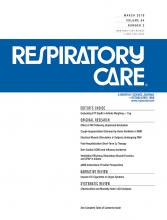We read with great interest the paper by Hart et al,1 recently published in Respiratory Care, regarding the impact of playing the harmonica on outcomes for people with COPD. As part of the FRESH AIR project,2 we have been developing and delivering pulmonary rehabilitation programs in the Kyrgyz Republic, Uganda, Vietnam, and Greece. Our recent work in the Kyrgyz Republic highlighted the potential for integrating music and dance into pulmonary rehabilitation. We did not specifically explore the potential use of traditional wind instruments, but the findings of Hart et al1 highlight this as an area to explore.
In June 2018, we conducted stakeholder interviews in hospitals and rural clinics throughout the Kyrgyz Republic, during which we explored individual and site-specific views physical activity in chronic lung disease, and the potential use of music and dance to improve engagement in pulmonary rehabilitation. We conducted semi-structured interviews and group discussions involving 42 subjects and 35 staff at 6 of the current trial sites of program delivery.
Because singing, music, and dance are major components of Kyrgyz culture, we explored perceptions on the potential use of music and dance as adjuncts to formal pulmonary rehabilitation (Fig. 1.). Responses from both subjects and staff at all sites were overwhelmingly positive, with comments such as “When we sing and dance, we live”; “When I dance, I stop thinking about my disease, and all the things that are wrong with me”; and “[Listening to] music takes me to another world.”
A traditional Kyrgyz instrument, the komuz. Courtesy of Carey Marks.
There was a clear and ubiquitous view that the addition of music, singing, and dancing would be feasible and welcome as adjuncts to the formal program as an engaging way to exercise, which might enhance participation, improve disease management, and boost mood and self-confidence. Few practical barriers to adding music and dance were mentioned. Some subjects also suggested that music could be played during the conventional exercise program, and at some sites this was already happening. On 4 occasions, discussions of singing, music, and dance resulted in group singing or dance sessions.
In summary, our findings highlight an eagerness to integrate music and dance into formal pulmonary rehabilitation programs in contexts outside the United Kingdom, such as the Kyrgyz Republic. The article by Hart et al1 further raises the potential of exploring the use of traditional instruments, which could provide further individualization and cultural adaptations of approaches to improve respiratory health.
Footnotes
The authors have disclosed no conflicts of interest.
- Copyright © 2019 by Daedalus Enterprises








